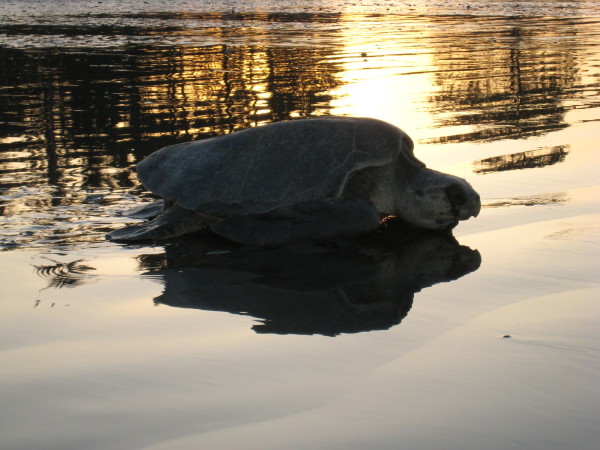The question of “where?” is simple to answer in the heart of the high season (January, February, March and mostly April).
Go west.

The Pacific half of the country is reliable for dry, warm, sunny weather for the beaches and activities inland in the forests and on the volcanoes. The most popular itineraries are designed to take in the western half of Costa Rica including Guanacaste, Nicoya, the Central Pacific, and the Osa.
Wildlife Watching January through March
After ensuring good beach weather the next question most travelers ask is “how’s the wildlife watching?”
On the Pacific side and in the central ranges the answer is “excellent.” How much you see depends a lot on how much you’re out and the birds and animals are more active on dry clear mornings and rain free evenings (great time for a night hike).
Sea Turtles
The wildlife watching calendars for January, February and March start out strong with arribadas of Olive Ridley sea turtles (peaks around 1/9, 2/5 and 3/3/2016) and the tail end of the leather back sea turtle nesting season on the Pacific. Green turtles are actively nesting all along the Pacific coast all three months.
These three months are some of the best for seeing baby sea turtles on the Pacific side as well. Since November and December are strong nesting months as well and the eggs incubate for 1 1/2 to 2 months there’s a continuous stream of hatchlings struggling out of the sand and down to the surf well into May.

The Caribbean is quiet for sea turtles. Olive Ridleys don’t nest on the east coast and Atlantic Green Turtles don’t start until May. The only significant activity is the beginning of the Caribbean leatherback season in March. See details of turtle watching in Costa Rica.
Humpback Whales
The California population of Humpback whales and their calves are commonly sighted off the southern Pacific coast this time of year. Nicoya and Guanacaste sightings are more common when they begin their migration north in late March. The North Atlantic Humpbacks from the St. Lawrence region are in residence in the Caribbean sea all three months but rarely spotted from shore. See details on whale watching in Costa Rica.
Resplendent Quetzals
The stars of the cloud forest tree tops can be seen around New Year’s but become easier to spot as they begin building nests in preparation for laying eggs around March or April. The timing of the quetzal nesting season varies a month or more depending on the fruiting of the wild avocado crop each year. In drought years (as early 2016 is expected to be due to El Niño) avocado development is typically delayed.
Other Wildlife
In addition to the seasonal wildlife mentioned above there are hundreds of thousands of birds that migrate from Canada and the U.S. to winter in tropical southern climes. Wetlands like Caño Negro, Palo Verde and Tortuguero see huge population booms on top of the large numbers of year round residents.

In general the dry season months of January to April are excellent for wildlife watching. Just like people the birds and animals tend to seek shelter during downpours and in the heat of the day so mornings in the dry season are particularly good times to take a nature walk. Monkeys and Sloths are two species we get a lot of questions and requests about and you’ll be happy to know they’re active and easy to find this time of year all over the country.
Tours, Adventures & Activities
High season is high season for a reason – the first three months of the year are a great time for all the tours and activities on the list of Costa Rica adventures. Zip-lines, waterfall rappels, guided nature hikes, mountain biking and dozens of other tours are all operating at peak capacity. The harvest is still going at higher elevation farms if you want to take a coffee tour.
Best Surfing January to April
The biggest most consistent waves from January to March are generated by winter cold fronts pushing into the Caribbean from the frozen north. Salsa Brava at Puerto Viejo is at its biggest, baddest and meanest.
If you’re not willing to brave the big waves or rainy weather that can accompany them on the Atlantic, the next best bet is Guanacaste and the Nicoya Peninsula. Offshores blow consistently the first three months of the year and storms in the north Pacific push swells (smaller than the May through September southern swells) powering good sets from Witch’s Rock south to Tamarindo and all the way along the peninsula to Santa Teressa.
The central and southern Pacific are angled more and sheltered by the Nicoya moderating the waves this time of year. It’s a good time to learn – take lessons at Jacó or Manuel Antonio.
Rafting
By April the natural free flowing rivers on the central Pacific (Naranjo, Savegre) may be too low to raft. Controlled rivers like the Balsa, Toro and Sarapiquí in the Arenal and north central regions typically have daytime water releases to generate electricity at their hydro plants and enough flow for rafting even if it’s not raining.
